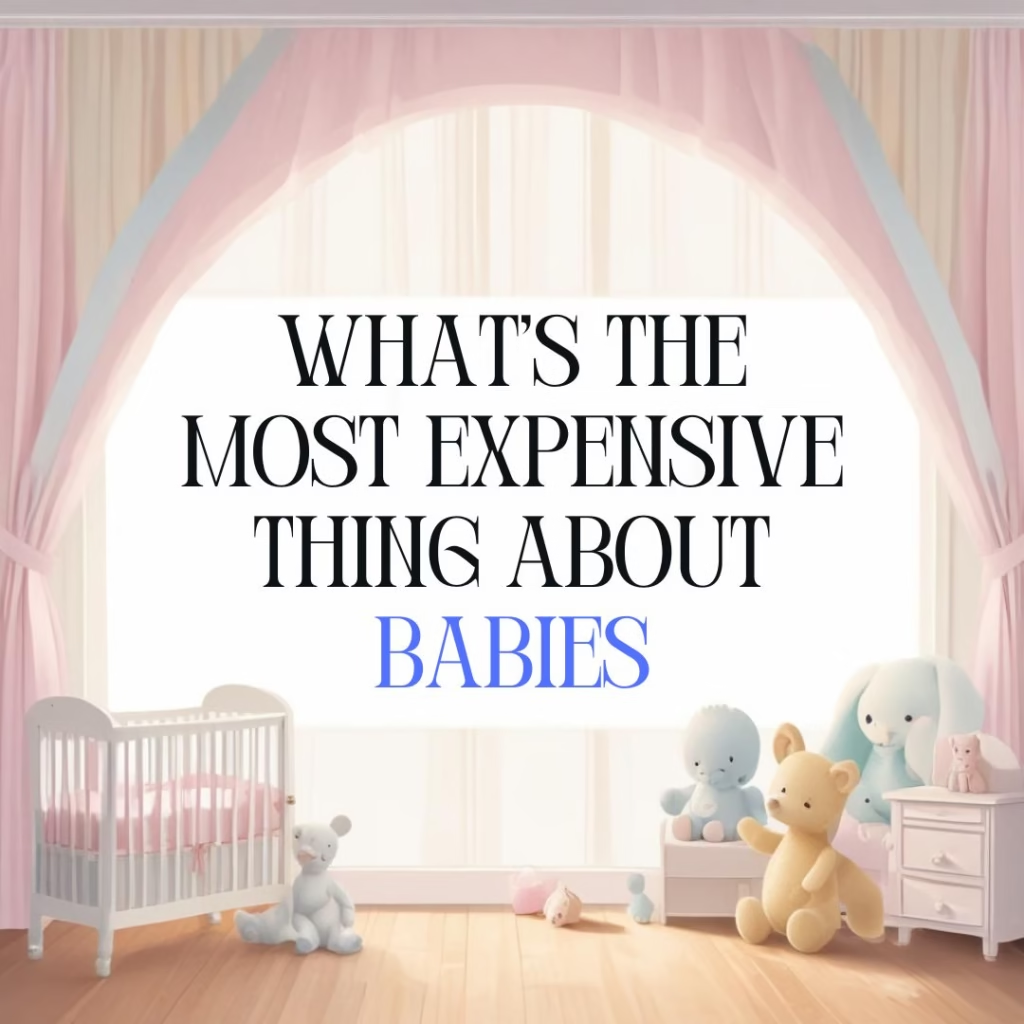Welcoming a baby into your life is one of the most joyous experiences, yet it brings substantial financial responsibilities. Understanding the costs of raising a child is crucial for parents to plan and budget effectively. One important consideration many parents have is what is the most expensive thing about a baby. This guide outlines the various expenses, from hospital bills and prenatal care to long-term commitments like education and childcare. By breaking down these significant financial aspects, parents can prepare themselves for the journey ahead and ensure they are ready to meet both the emotional and financial demands of parenthood.
Initial Costs
Hospital and Delivery Expenses
The cost of childbirth can differ significantly based on factors such as your location, the healthcare provider you choose, and whether you have insurance coverage.
Typical Costs
In the United States, the expenses associated with hospital deliveries typically range from $5,000 to $15,000 or even higher for those without insurance. This wide range reflects variations in hospital fees, the type of delivery (vaginal or cesarean), and the specific services rendered.
- In 2020, the median cost of a vaginal delivery in Mississippi was $6,557, while in California it was $16,668.
- In 2020, the median C-section cost in Mississippi was $9,377, while in Alaska it was $27,527.
The Role of Insurance
Having health insurance can greatly alleviate the financial burden of childbirth, as many plans cover a substantial portion of these costs. For expectant parents wondering “what is the most expensive thing about a baby”, it’s crucial to carefully review their insurance policy details, including deductibles, copayments, and any exclusions that may apply, to understand their out-of-pocket expenses better. By being informed about these factors, parents can better prepare for the financial aspects of welcoming a new child into their family.
Employer-Sponsored Health Insurance
- Coverage: Maternity and childbirth care as part of essential health benefits under the ACA.
- Benefits: Includes prenatal, labor, delivery, and postnatal care.
- Costs: Involves deductibles, copays, and shared premiums.
Individual Health Insurance Plans
- Coverage: ACA marketplace plans must include maternity coverage.
- Benefits: Similar to employer plans but tailored to individual needs.
- Costs: Vary by age, location, and income; subsidies may be available.
Medicaid
- Eligibility: For low-income individuals and families; income thresholds vary by state.
- Coverage: Comprehensive maternity care, including prenatal and postpartum visits.
- Costs: Minimal or no out-of-pocket expenses.
Children’s Health Insurance Program (CHIP)
- Eligibility: For pregnant women ineligible for Medicaid, meeting income requirements.
- Coverage: This may include prenatal care and delivery.
- Costs: Low premiums and cost-sharing.
Short-Term Health Insurance
- Coverage: Typically does not cover maternity as it’s considered a pre-existing condition.
- Use Case: For uninsured individuals; not suitable for pregnancy care.
Supplemental Maternity Insurance
- Types: Includes maternity riders and hospital indemnity plans.
- Benefits: Provides lump-sum payments for childbirth-related costs.
- Limitations: Must be purchased before pregnancy.
Tricare
- Eligibility: Available to military personnel and families.
- Coverage: Comprehensive maternity care.
- Costs: Minimal out-of-pocket expenses depending on the plan.
COBRA
- Use Case: For those who lose employer-sponsored insurance during pregnancy.
- Coverage: Extends existing benefits, including maternity care.
- Costs: High premiums as individuals pay the full cost of the plan.
Nursery Setup
Establishing a nursery is one of the significant initial expenses for new parents.
Essentials
Key items such as cribs, changing tables, and mattresses are essential for creating a functional and safe space for your baby. On average, these necessities can cost between $500 and $2,000, depending on the quality and brand you choose.
Extras
In addition to the essentials, many parents opt for extra items that enhance the nursery’s comfort and aesthetics. Luxury additions, such as decorative elements, high-end rocking chairs, and custom furnishings, can substantially raise your overall budget. While these items can create a beautiful and cozy environment, it’s important to balance your desires with practical financial considerations. By prioritizing essential items first, you can create a nurturing space for your baby while managing costs effectively.
Ongoing Expenses
Diapers and Wipes
Diapers and wipes are fundamental necessities for caring for a baby, as they are used daily to maintain hygiene and comfort. When considering “what is the most expensive thing about a baby”, it’s important to recognize that these daily essentials can significantly impact a family’s budget over time.
Costs
Parents can expect to spend approximately $70 to $80 each month on disposable diapers and wipes. This recurring expense can add up quickly, making it a significant part of the monthly budget for new parents.
Cloth vs. Disposable
When choosing diapering options, parents typically consider cloth and disposable diapers. Cloth diapers are eco-friendly and cost-effective over time, as they are reusable, though they require more effort for washing and maintenance. In contrast, disposable diapers offer convenience and ease of use, eliminating laundry but leading to ongoing monthly costs and environmental impact. Parents should evaluate the pros and cons of each option to find the best fit for their lifestyle and budget.
Formula and Baby Food
Feeding your baby represents another significant and ongoing expense for new parents.
Formula Feeding
For those who choose formula feeding, the costs can range from $100 to $150 per month, depending on the brand and type of formula selected. This expense may vary based on your baby’s nutritional needs and any special formulas that might be required.
Baby Food
As your baby transitions to solid foods, the cost of baby food becomes significant. Parents can choose convenient store-bought jars, which can be expensive, or prepare homemade baby food, which is often more economical. Making baby food at home not only saves money but also allows parents to control ingredients and introduce a variety of fresh fruits and vegetables. Understanding these feeding costs helps parents budget effectively and make informed choices that suit their family’s needs.
Clothing and Gear
Babies experience rapid growth, necessitating frequent updates to their wardrobes to accommodate their changing sizes.
Clothing
Parents should budget approximately $50 to $100 each month for essential baby clothing. This includes basics like onesies, sleepers, and seasonal outfits. As babies grow, they will quickly outgrow their clothes, making it important to assess and refresh their wardrobe regularly.
Gear
In addition to clothing, parents should account for the costs of essential baby gear. Items like strollers, car seats, and baby carriers are important upfront investments that ensure convenience and safety. These products not only provide comfort for the baby but also simplify transportation for parents. Investing in high-quality gear enhances the parenting experience and offers peace of mind regarding your child’s safety. By understanding these clothing and gear expenses, parents can better plan their budgets and prepare for their baby’s growing needs.
Childcare Costs
Daycare and Nanny Services
For working parents, childcare typically represents one of the largest expenses in the family budget.
Daycare
The cost of daycare can vary significantly, ranging from $900 to $1,500 per month based on factors such as location, facility quality, and the age of the child. Parents should consider both the affordability and the quality of care when selecting a daycare provider to ensure their child is in a safe and nurturing environment.
Nanny
Hiring a nanny is generally a more costly option, often exceeding $2,000 per month. While this provides the benefit of personalized attention and flexible schedules, it can place a considerable strain on the family budget.
Babysitting and Extracurricular Activities
As children grow, additional expenses arise from occasional babysitting and extracurricular activities.
Babysitting
For occasional childcare needs, babysitting rates typically range from $15 to $20 per hour. This can add up quickly, especially for parents who need regular help.
Activities
Extracurricular activities, such as music classes or gym memberships for toddlers, can also contribute to the monthly budget, costing between $50 and $100. These activities not only enrich a child’s development but also provide opportunities for social interaction and physical activity.
Health and Medical Expenses
Routine Check-ups and Vaccinations
Regular pediatric visits and vaccinations are essential for your baby’s health and development.
Routine Care
Parents can anticipate spending between $500 and $1,000 annually on routine check-ups and vaccinations, depending on their insurance coverage and the specific healthcare provider. These visits are crucial for monitoring your baby’s growth, administering necessary vaccinations, and addressing any health concerns that may arise.
Unexpected Medical Costs
In addition to routine care, parents must be prepared for unexpected medical expenses.
Emergency Visits
Whether due to an unforeseen illness, injury, or specialized treatment, emergency medical visits can incur significant costs. These expenses can quickly add up, so it’s important to be financially prepared.
Planning Ahead
To manage these potential costs effectively, consider establishing a savings fund or a flexible spending account (FSA) specifically for unplanned medical expenses. By planning ahead, parents can ensure they have the financial resources to address any unexpected healthcare needs without undue stress. This proactive approach can provide peace of mind and help maintain your baby’s health and well-being.
Long-term Financial Impact
Education Savings
Planning for your child’s education is a crucial long-term consideration that requires early preparation, especially when considering “what is the most expensive thing about a baby”.
Saving Options
To help parents save for future educational expenses, options such as 529 college savings plans and custodial accounts are available. A 529 plan offers tax advantages and can be used for qualified education expenses, making it a popular choice for many families. Custodial accounts, on the other hand, allow parents to save money in their child’s name, which can be used for various purposes, including education. Starting to save early can significantly ease the financial burden of college tuition down the line.
Lifestyle Changes
Welcoming a baby into your family inevitably impacts your household budget and lifestyle.
Adjust Goals
As parents manage the financial demands of childcare and baby-related expenses, they often need to adjust their financial priorities. This may involve reallocating funds from discretionary spending to cover essentials like diapers, baby gear, and childcare. Parents might also have to rethink their savings goals for vacations, home improvements, or retirement. By acknowledging these shifts and planning accordingly, they can create a budget that meets their child’s needs while supporting long-term financial goals. Balancing these priorities is crucial for maintaining financial stability and providing the best for their growing family.
Conclusion
Welcoming a baby is a joyous occasion, but it comes with significant financial responsibilities. Understanding the various costs associated with raising a child—from hospital bills and routine check-ups to long-term expenses like education and childcare—is essential for effective budgeting. One common question parents ask is, “What is the Most Expensive Thing About Babies?” This guide highlights the key financial aspects parents will face, helping them prepare for both the emotional and financial challenges of parenthood. By being informed and planning ahead, parents can navigate this rewarding journey with confidence and stability.
Here is a short summary of all the expenses to expect
| Category | Item | Average Cost |
|---|---|---|
| Initial Costs | Hospital and Delivery | $5,000–$15,000+ |
| Nursery Setup | $500–$2,000+ | |
| Ongoing Expenses | Diapers and Wipes | $70–$80/month |
| Formula Feeding | $100–$150/month | |
| Baby Food | $50–$100/month | |
| Clothing | $50–$100/month | |
| Baby Gear | $300–$1,000+ (one-time) | |
| Childcare Costs | Daycare | $900–$1,500/month |
| Nanny | $2,000+/month | |
| Babysitting | $15–$20/hour | |
| Health and Medical | Routine Check-ups | $500–$1,000/year |
| Emergency Costs | Varies | |
| Long-term Costs | Education Savings | $100–$500/month (savings plan) |
| Extracurricular Activities | $50–$100/month |
FAQs
- What is the most expensive thing about having a baby?
Childcare is often the most costly aspect, averaging $900 to $2,000 per month. - How much does it cost to deliver a baby?
Delivery costs range from $5,000 to $15,000 without insurance, depending on your location. - What is the most expensive thing about having a baby cloth diapers or disposable ones?
Yes, cloth diapers save money over time but require more effort to clean and maintain. - How much do parents spend on baby formula?
Parents spend $100-$150 per month on formula, depending on the brand. - What are the most expensive thing i.e., hidden costs about having to raise a baby?
Hidden costs include babysitting, extracurricular activities, and unexpected medical expenses. - How do you save money on baby clothing?
Buy second-hand clothes or take advantage of seasonal sales. - Is a nanny more expensive than daycare?
Yes, a nanny typically costs more, often exceeding $2,000 monthly. - Do babies need health insurance?
Yes, health insurance is crucial for covering routine check-ups, vaccinations, and emergencies. - How can I reduce nursery setup costs?
Focus on essentials and consider second-hand furniture to save money. - What is the average cost of raising a child annually?
The USDA estimates the cost to be approximately $12,000-$14,000 annually, excluding education.
Thanks for reading, for more interesting articles, visit our homepage.



